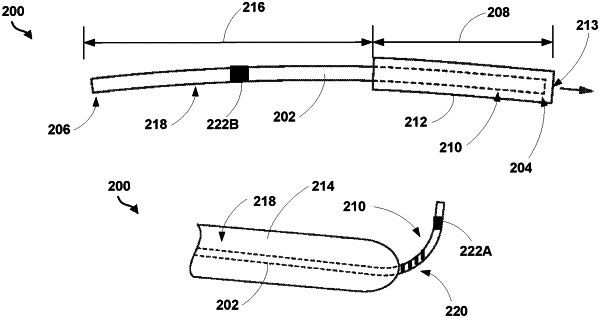| CPC A61B 17/7291 (2013.01) [A61F 2/4225 (2013.01); A61B 2017/00862 (2013.01); A61B 2017/00867 (2013.01); A61B 2017/00946 (2013.01); A61F 2002/4228 (2013.01)] | 14 Claims |

|
1. A method comprising:
introducing a second end of a wire into a joint of a patient, wherein the wire includes a first portion including a first end and a second portion including the second end opposite the first end, wherein a longitudinal axis of the first portion of the wire is positioned at a non-zero angle with respect to a longitudinal axis of the second portion of the wire with the longitudinal axes not coaxial, wherein the first portion of the wire is superelastic in ambient air and the longitudinal axis of the first portion of the wire is configured to return to the non-zero angle after bending, and wherein the second portion of the wire is superelastic in ambient air and is configured to return to a straight configuration along the longitudinal axis of the second portion of the wire after bending;
removing the first end of the wire from a lumen of a sleeve to transition the wire from a constrained state to an unconstrained state, wherein the first portion of the wire is removably positioned at least partially in the lumen of the sleeve, wherein the first portion of the wire is in the constrained state when the first portion of the wire is positioned at least partially in the lumen of the sleeve during the introducing of the second end of the wire into the joint of the patient, wherein the longitudinal axis of the first portion of the wire is substantially aligned with the longitudinal axis of the second portion in the constrained state, wherein the sleeve is configured to remain outside of a body of the patient during the introducing of the second end of the wire into the joint of the patient, wherein the first portion of the wire is in the unconstrained state when the first portion of the wire is removed from the lumen of the sleeve after the introducing of the second end of the wire into the joint of the patient, and wherein the longitudinal axis of the first portion of the wire returns to the non-zero angle with respect to the longitudinal axis of the second portion of the wire in the unconstrained state;
positioning the second end of the wire through a lumen in a hammertoe implant; and
positioning the hammertoe implant in the joint.
|